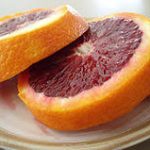O is for Orange
 I'm not sure that I really understand what genetic modification is. What I do know is that, even leaving genes out of the equation, mankind has been mucking about with its fruit and veg for centuries. Never more it seems, than with today's hero, the orange.
I'm not sure that I really understand what genetic modification is. What I do know is that, even leaving genes out of the equation, mankind has been mucking about with its fruit and veg for centuries. Never more it seems, than with today's hero, the orange.
Given the ubiquity of the fruit, it surprised me to learn that the orange tree is not a wild plant. It's a hybrid between a mandarin and a pomelo, originating in an area which encompasses northeast India, Myanmar (Burma) and southern China. Very broadly there are two main types, bitter and sweet. The earliest known reference to sweet oranges comes from Chinese literature in 314 BC.
It is now to be found worldwide. I might have nicked a point off you if I'd asked you to name the world's largest producer. The answer? Brazil, accounting for about 22% of global production. The name comes from Sanskrit. In an anglicised version this was nagranga or nagrungo, meaning orange tree (cf Spanish naranja or Italian arancia.) The dropping of the initial n probably came from countries which used the words un or une for the indefinite article. Thus une orange sounded better than une norange. (If you want to be a real smartarse, you can point out that this is known as juncture loss.)
Nowadays there are dozens if not hundreds of varieties of sweet oranges (do you still find a wee one in your Christmas stocking?), but they split into four main categories, common, navel, blood and acidless. Once prevalent in the Middle East, it has been suggested that the large quantities of water required for their cultivation contributed to the large areas of arid desert now to be found. Who knows? It would probably be too hot there now. The ideal temperature for their growth is between 15˚ and 30˚C, which explains why problems are now being encountered in southern Spain, once one of the most important growing centres.
So, we eat them and we drink the juice. The latter is traded on the commodities futures market on Wall Street. But there's so much more. The oil extracted from the peel is an important part in any aromatherapist's armoury. From the skin we also extract D-limonene, which is used in detergents, hand cleaners and wood polish.

Navel Orange
Then the navel. So called, obviously enough, because of the resemblance to a belly button. The "navel" as you will know if you've ever eaten one, is caused by the orange trying to grow another one inside itself. Pause to marvel. What sort of grafting techniques can make an orange think it's pregnant? Middle Ages black magic, I would say, though with a delicious end result. Which, to be frank, is more than you can say for that other seasonal worthy, the blood orange.

Blood Orange
Wearing my cook's hat, I used to get quite excited about these. A segment or two as a garnish looks very pretty. I suppose you can use it to make quite an attractive sorbet. But when was the last time you peeled one and ate it as a conventional fruit? Whisper it, but they're not very nice.
Finally, acidless. I'm not sure I'd heard the term either. Known as sweet oranges in the USA, douce in France, dolce or Maltese in Italy, they are very popular in the near East. The reason we don't know about them is because they spoil easily and aren't suitable for export or for juicing. Not, therefore, to be found on our shelves, but worthwhile bearing in mind when you're on your travels.
So, everything you need to know about (sweet) oranges in a few short paragraphs. And, of course, we make marmalade. But that's best with the bitter ones, and we'll have more of that in Friday's Tom Cooks!
A fascinating fruity dialogue, thank you
Many thanks. Toodle pip, old fruit.
An norange 👍👏👏👏👏👏🥃
I should have thought of that under N.